Did you know one in five couples meet online?
In recent years, the world of dating has been significantly transformed by the emergence of many innovative technologies, one of them being Augmented Reality and Virtual Reality.
With growing dependence on these technologies, they haven’t only shaped our interaction, but also have changed the way we date. These revolutionary technologies have started offering immersive experimental platforms for seeking potential partners.
In this blog, we will delve into how AR and VR are shaping the dating industry and explore the key advancements that are enhancing the user experience and redefining the search for love and companionship.
Let’s get to know about it.
Understanding Virtual and Augmented Reality
Due to AR/VR trends, a new era of romance has begun in dating apps. And, it’s going to see a huge shift in the upcoming future as well.
These apps provide users with engagement and interaction that is unattainable through traditional platforms.
By leveraging AR, users are able to superimpose virtual elements onto their real-world surroundings, thereby expanding possibilities of expression and creativity.
For example, AR in dating apps can be used to verify user identity through facial recognition and other biometric data to enhance security.
On the other hand, VR technologies enable individuals to create personalized avatars, explore virtual spaces, and communicate with potential matches in a way that closely imitates face-to-face interaction.
This is why it became a top trend to look forward to.
Without any second thought, these cutting-edge advancements in dating apps promise to deliver extraordinary convenience and engagement.
Role of AR and VR in Dating Apps
Proper planning & execution is crucial for the successful implementation of VR & AR in dating apps.
As dating apps evolve, their seamless integration with virtual and augmented reality technologies promises to redefine the romantic experience, offering users with amazing experience.
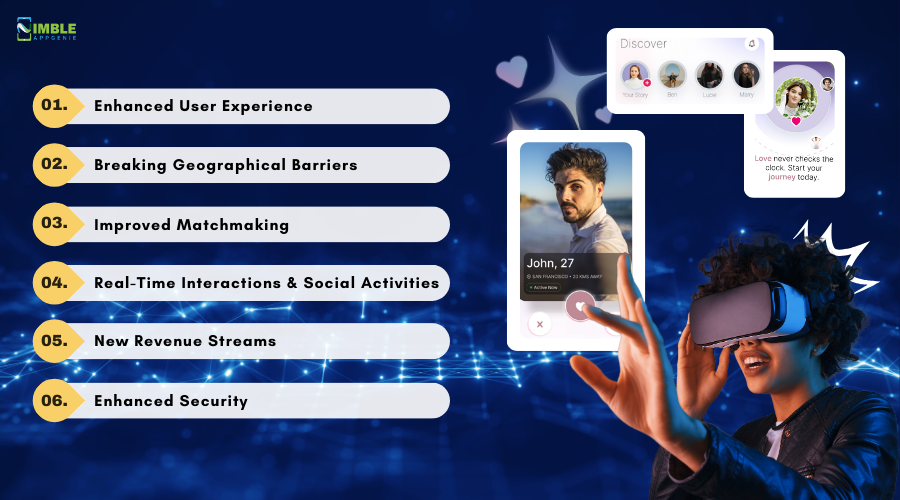
1. Enhanced User Experience
As the market is growing at a tremendous rate, investors are taking the help of AR and VR to enhance the experience of users within dating apps.
By leveraging AR filters, users are creating interactive and engaging profiles, while VR technology can transport users to immersive virtual environments for virtual dates.
These features provide a dynamic and personalized experience compared to the traditional swiping-based platforms.
2. Breaking Geographical Barriers
Dating apps often face limitations due to geographical limitations.
With AR and VR in dating apps, this bridge can be filled with shared virtual spaces where users from different locations can interact and connect.
As a result, this expansion of the dating pool can lead to more diverse and inclusive matches.
3. Improved Matchmaking
To turn your dating app idea into a huge success, better matchmaking is important.
AR and VR can give valuable data on user behavior, preferences, and interactions within virtual environments.
This information can be used to refine matchmaking algorithms, resulting in more compatible matches based on shared interests and virtual experiences.
4. Real-Time Interactions and Social Activities
One of the most significant impacts of AR and VR on dating apps is the easing of real-time interactions and social activities.
Through AR-powered features, users can engage in virtual conversations and shared activities within their immediate surroundings, breaking down the barriers of physical distance and enabling better interaction.
Similarly, VR environments offer the opportunity for individuals to partake in virtual events, improving the connection.
5. New Revenue Streams
AR/VR opens up new revenue opportunities for dating apps.
If you integrate some amazing dating app features that include a virtual experience, or sponsored virtual events, it can help you generate additional income.
So, you should create a dating app with a robust monetization strategy that leverages the potential of AR/VR.
6. Enhanced Security
Security is a huge concern in online dating.
Over half (55%) of those surveyed encountered threats while online dating. So, it becomes necessary to focus on data and app security.
AR/VR technology in dating apps can offer extra safety measures and can help you eliminate major issues. For instance, users can verify their identity through facial recognition or create secure virtual meeting spaces for safety.
Dating app features focusing on safety will not only build trust and confidence among users.
Importance of AR and VR in Dating Apps
Whether you want to create a video dating app or a niche-based dating app, you need to understand the importance of AR and VR integration in dating apps.
Here are some of them:
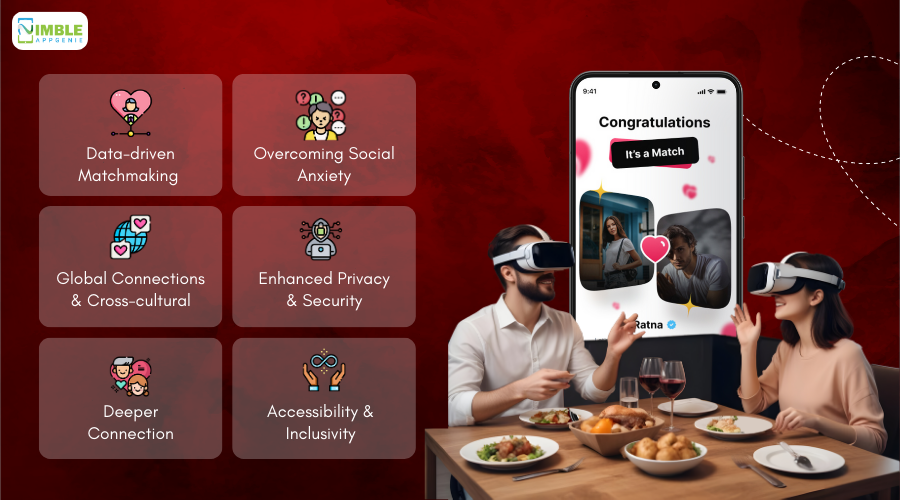
-
Data-Driven Matchmaking for Personalized Experience
There are so many top dating apps including Bumble & Tinder already present in the market.
To get a competitive edge, the integration of AR and VR is important as it provides you with a lot of valuable data on user behavior and preferences.
This data can be leveraged to refine matchmaking algorithms, delivering highly personalized experiences tailored to individual tastes and interests.
-
Overcoming Social Anxiety Through Virtual Interactions
For individuals dealing with social anxiety, virtual dating can be a helpful way to provide a comfortable and controlled environment to initiate connections.
By slowly building confidence in virtual spaces, users can push the boundaries to in-person more smoothly.
See it is no wonder that a controlled and immersive environment empowers users to build confidence. This way, users can practice interactions, experiment with different conversation starters, and receive real-time feedback without the fear of judgment associated with in-person encounters.
-
Global Connections & Cross-Cultural Dating
Another importance of AR and VR in dating apps is it removes geographical barriers, enabling users to connect with potential matches worldwide.
This also introduces people to other cultures promotes cross-culture dating and expands the dating pool considerably, similar to the impact seen in apps like Badoo.
-
Enhanced Privacy and Security
Safety remains a paramount concern in the realm of dating apps.
It’s important to implement various safety features and robust verification systems such as facial recognition and biometric authentication. After all, minimizing the risk of fake profiles and catfishing remains a common development pitfall in the dating app journey.
Additionally, AR can be utilized to create safer virtual meeting spaces where users can interact without revealing personal information. VR on the other hand, can facilitate secure virtual environments for initial interactions, allowing users to assess compatibility.
-
Deeper Connections through Immersive Experiences
Traditional ways of finding love have been replaced by swiping features and with the growing dating app trend of VR and AR in dating apps, these apps will see a new reform.
Through virtual environments and interactive elements, potential matches can assess compatibility beyond just swipes, similar to real-life interactions.
-
Accessibility & Inclusivity
AR/VR could make dating apps more accessible to people with disabilities.
By providing alternative ways to interact and connect, dating apps can create a more inclusive environment.
Taking steps towards accessibility and inclusivity will be driven by the integration of AR/VR technology.
Challenges & Considerations
Integrating AR & VR in dating apps presents unique development challenges in a dating app.
Let’s get to know about it one by one.
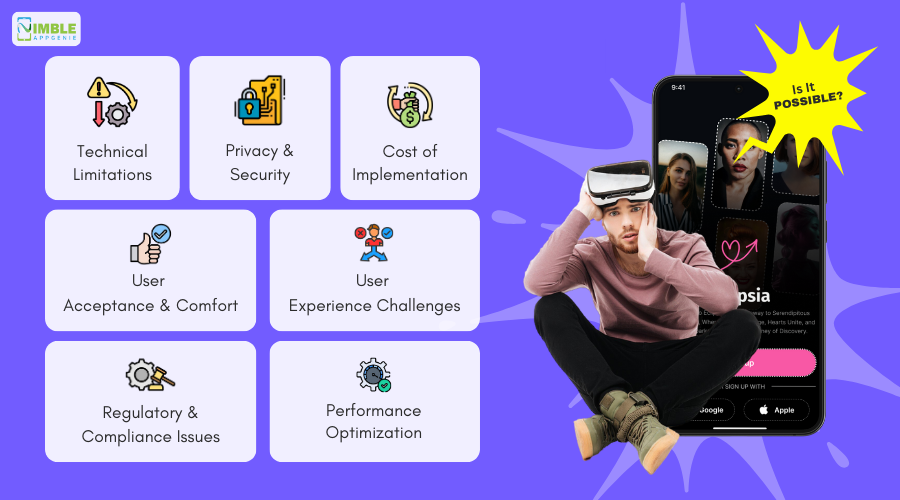
♦ Technical Limitations
The current state of AR and VR technology might not be advanced enough to provide seamless and immersive experiences for all users.
Issues like hardware compatibility, latency, and graphics quality can hinder adoption.
Considerations:
- You can focus on developing AR and VR experiences that are compatible with a huge range of devices and operating systems.
- This approach allows users with older devices or those who prefer traditional experiences to still enjoy the app.
♦ Privacy & Security
As with any technology that collects user data, there are privacy concerns that we have already shared with you.
So, protecting user information and preventing misuse is important.
Considerations:
- Utilize secure and strong authentication models like multi-factor authentication and biometric authentication.
- You can implement robust content moderation systems to filter out inappropriate or harmful content.
♦ Cost of Implementation
Developing and implementing AR and VR in dating can be a costly affair. This can also affect the development cost of a dating app.
Considerations:
- Prioritize essential dating app features while exploring cost-effective AR/VR integrations that complement the core functionality.
- You can leverage existing AR/VR development tools and platforms to reduce overall development time and cost.
♦ User Acceptance and Comfort
Some users might feel hesitant to use AR and VR for dating, especially those who are less tech-savvy or have privacy concerns.
Considerations:
- Conduct proper app testing to gather feedback on user experience and identify areas for improvement.
- Introduce AR and VR features incrementally, allowing users to become accustomed to the technology at their own pace. This approach can help alleviate anxiety and build trust.
♦ User Experience Challenges
Getting accepted by users is one of the challenges for these apps.
Take LGBTQ dating apps as an example: it’s important to balance immersive experiences with opportunities for authentic interaction. Other than that, general dating apps also face several issues.
Considerations:
- Prioritize features that allow for shared experiences, meaningful conversations, and emotional connections.
- Empower users to customize their virtual experiences and choose the level of immersion that suits their preferences.
♦ Regulatory & Compliance Issues
Making sure that AR and VR comply with dating regulations and standards can be a challenging task.
Considerations:
- Make sure to adhere to data protection regulations including GDPR and CCPA while handling sensitive user data collected through AR and VR interactions.
- Protecting intellectual property rights related to AR/VR content, user-generated content, and the app itself.
♦ Performance Optimization
Another issue is maintaining high performance for immersive AR/VR experiences to prevent motion sickness and ensure user satisfaction.
AR/VR apps need to work well on different devices.
Considerations:
- Leverage device-specific features and APIs for enhanced performance.
- Thoroughly test the app on different devices to identify performance bottlenecks.
The Future of AR and VR in Dating Apps
Speaking about the future of AR and VR, we know they are constantly going to advance at a rapid pace; the future of dating holds a lot of potential for transforming experiences and innovative functionalities.
The integration of haptic feedback, spatial audio, and sensory immersion is poised to further enhance the realm and depth of virtual interaction.
Meaning, it will even offer users a captivating and authentic dating experience. Additionally, the incorporation of AI in dating apps including AR and VR technologies promises to refine the whole process of making matches, leading to more accurate and personalized recommendations.
How Nimble AppGenie Company Help You to Incorporate AR/VR in Your Dating App?
Leveraging emerging technologies to stay at the forefront of the competition is crucial for dating apps. To do so, Nimble AppGenie, the best dating app development company is here to help.
Our expert team specializes in seamlessly integrating immersive experiences into your platform, enhancing user engagement and driving growth.
With us, you can unlock the full potential of AR/VR, a dating app that stands out in a crowded market. Connect with us.
Conclusion
In conclusion, the influence of AR and VR on dating apps has proven to be profound, reshaping the way individuals connect and form relationships in the digital age.
From enhanced user engagement to immersive virtual environments, these technologies have ushered in a new era of interactive and experiential dating, redefining the boundaries of connection and intimacy.
As we look toward the future, it is evident that AR and VR will continue to play a pivotal role in shaping the landscape of dating apps, offering users an evolving array of possibilities for finding love and companionship in an increasingly digital world.
FAQs
AR and VR technologies offer advanced security features like facial recognition, biometric verification, and secure virtual meeting spaces. These features can significantly reduce the risk of scams and fake profiles, creating a safer environment for users.
Challenges include technical limitations, user acceptance, content creation, privacy concerns, and cost. Overcoming these challenges requires careful planning, investment in technology, and a focus on user experience.
AR and VR can break down barriers for users with disabilities by providing alternative ways to interact and communicate. Features like audio descriptions, haptic feedback, and customizable avatars can create a more inclusive dating environment.
Some innovative features include virtual try-ons of outfits, augmented reality filters for profile enhancement, virtual dating spaces, and interactive games to foster connection.
By investing in research and development, partnering with technology providers, and focusing on user experience, businesses can create engaging and successful AR/VR dating apps. Understanding user needs and preferences is crucial for long-term success.

Niketan Sharma is the CTO of Nimble AppGenie, a prominent website and mobile app development company in the USA that is delivering excellence with a commitment to boosting business growth & maximizing customer satisfaction. He is a highly motivated individual who helps SMEs and startups grow in this dynamic market with the latest technology and innovation.
Table of Contents




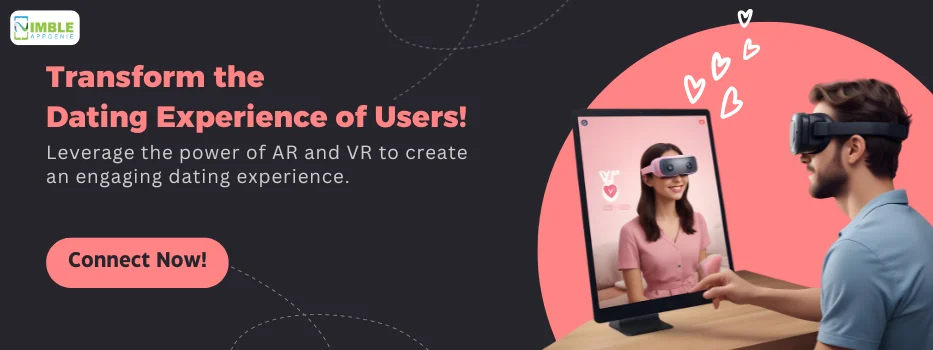
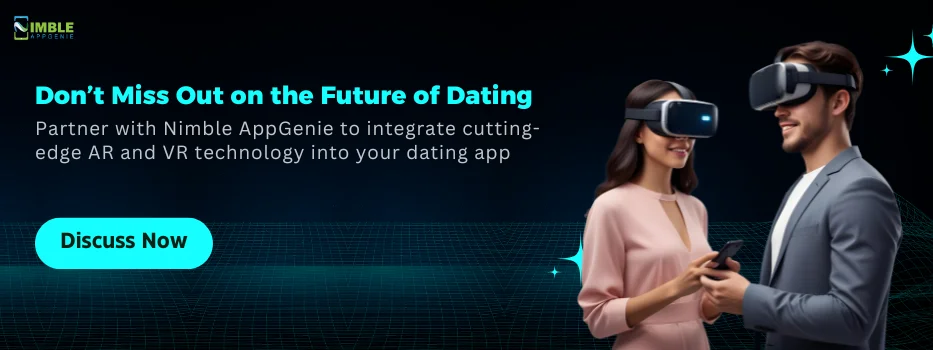
No Comments
Comments are closed.